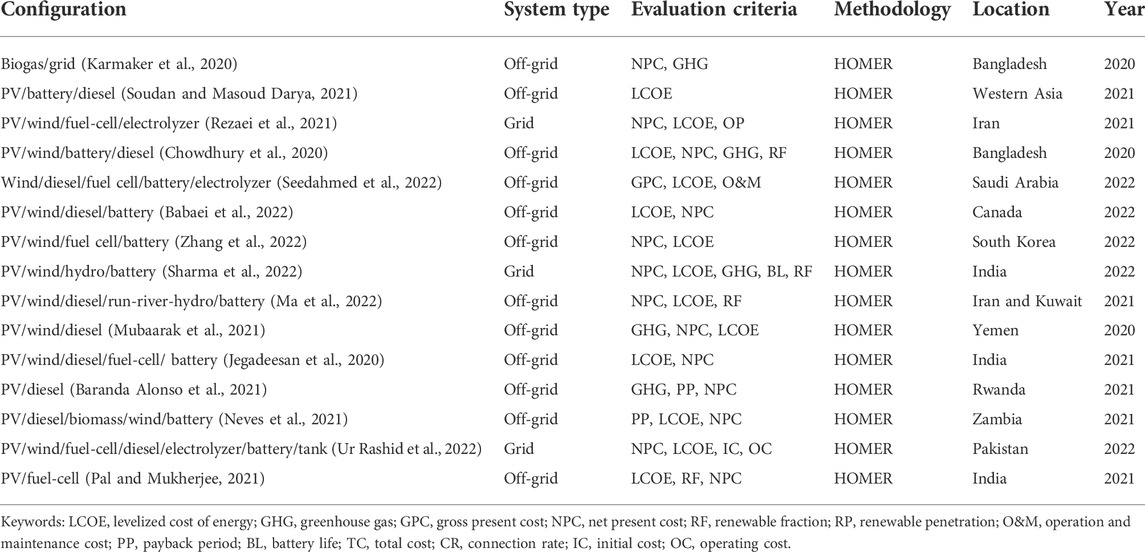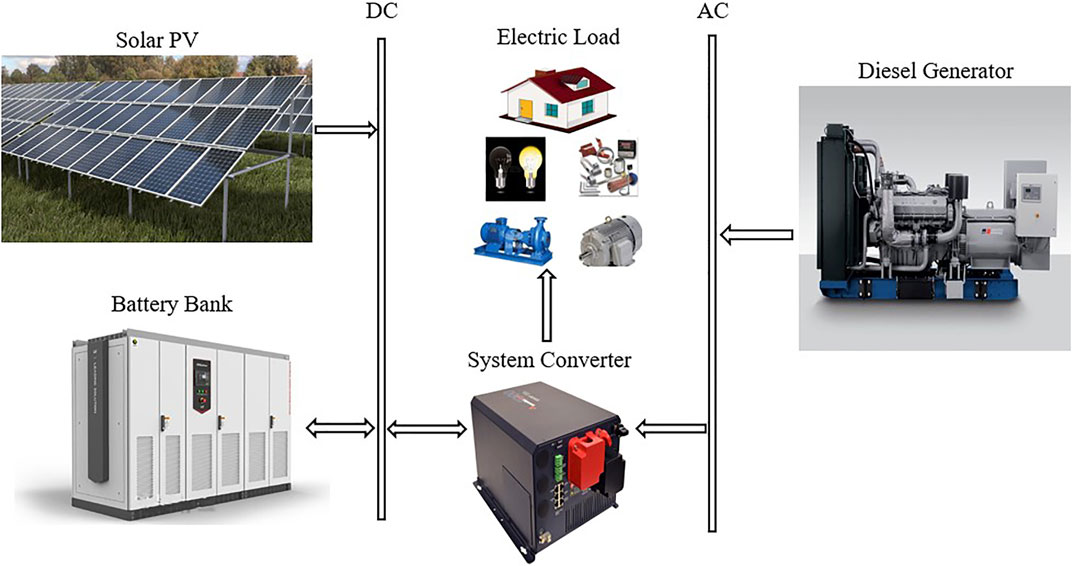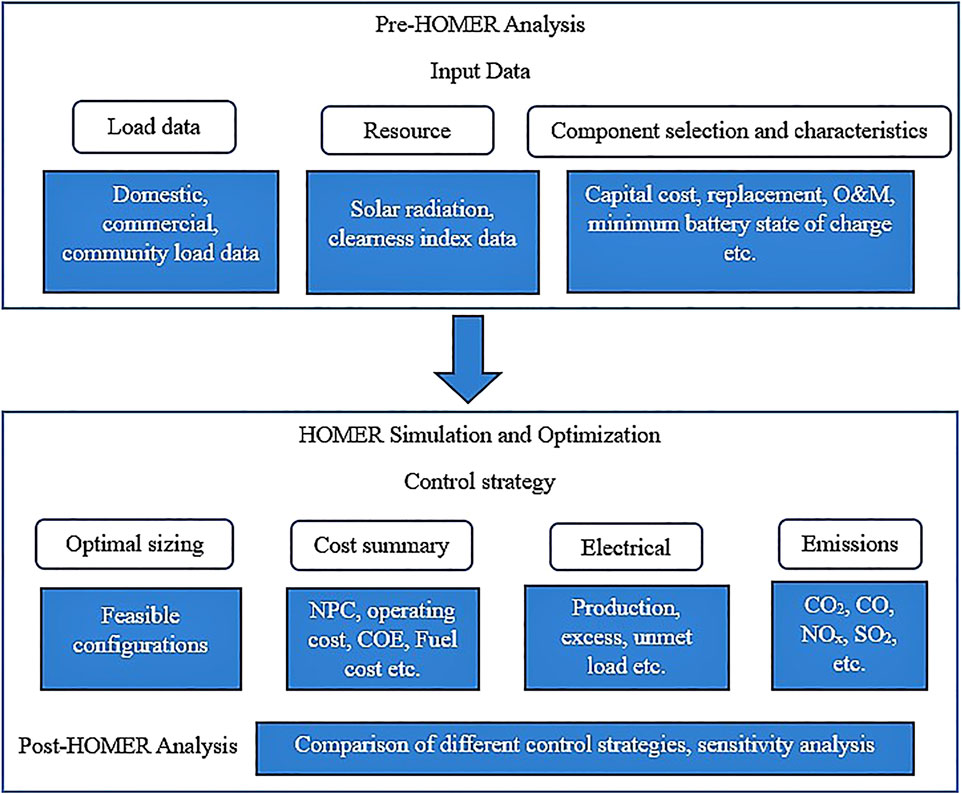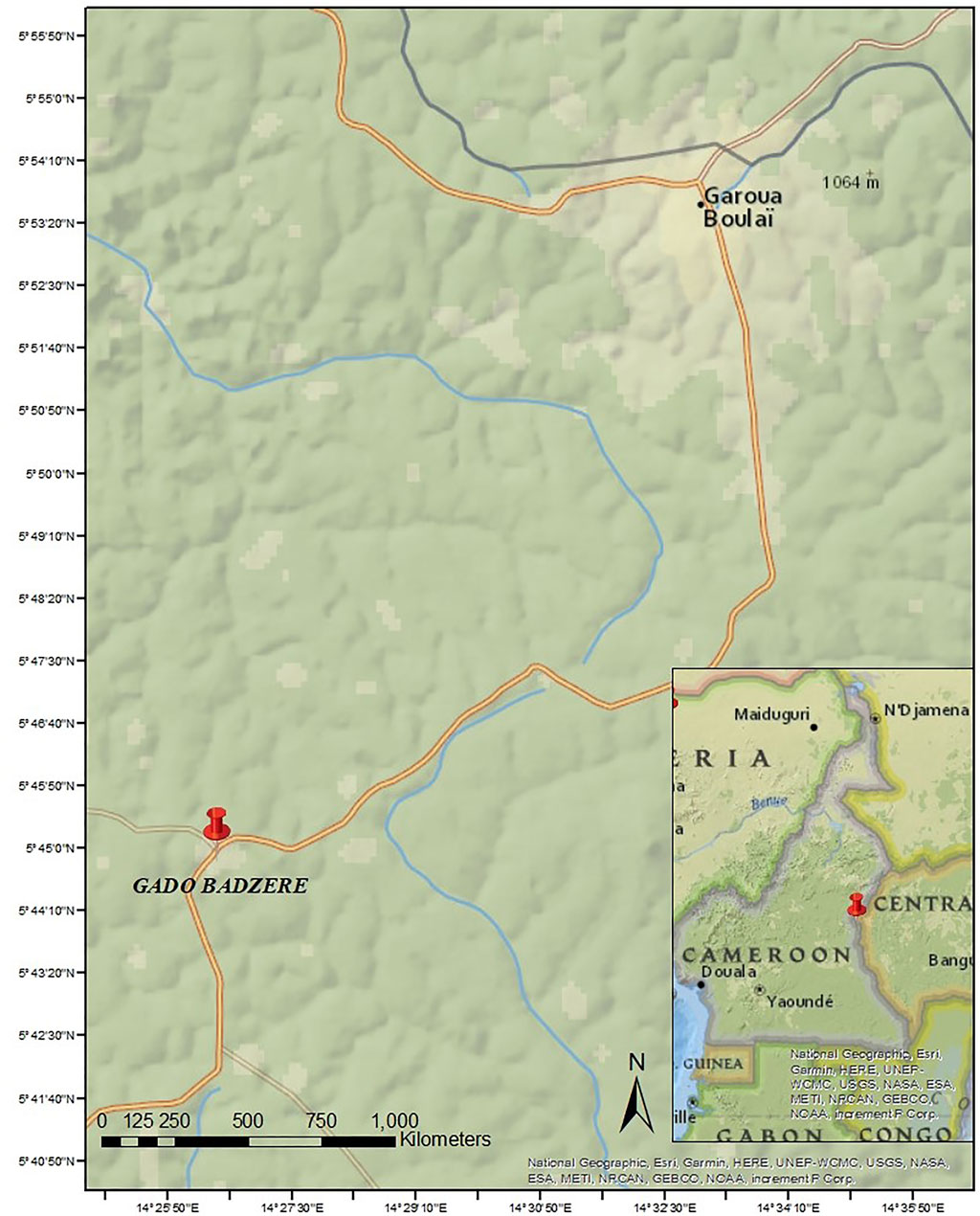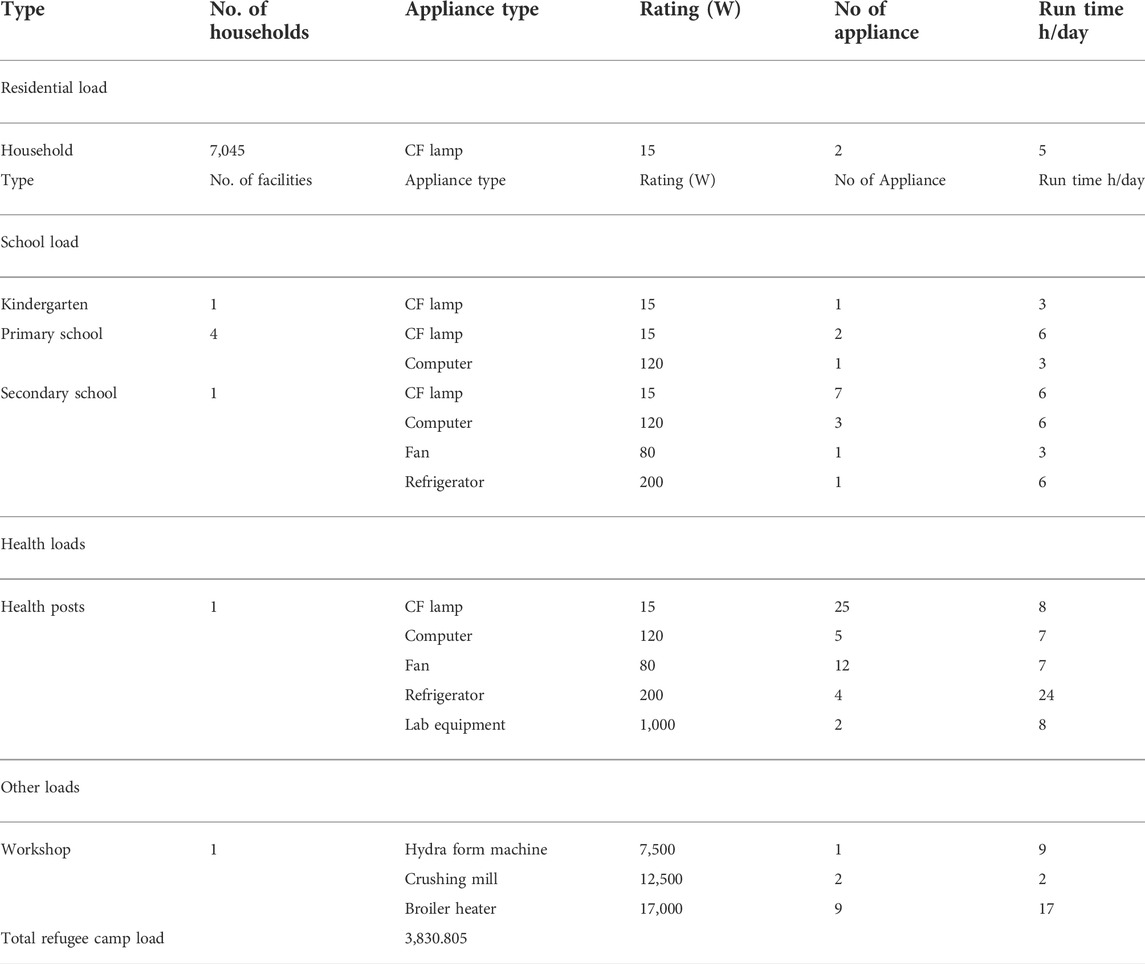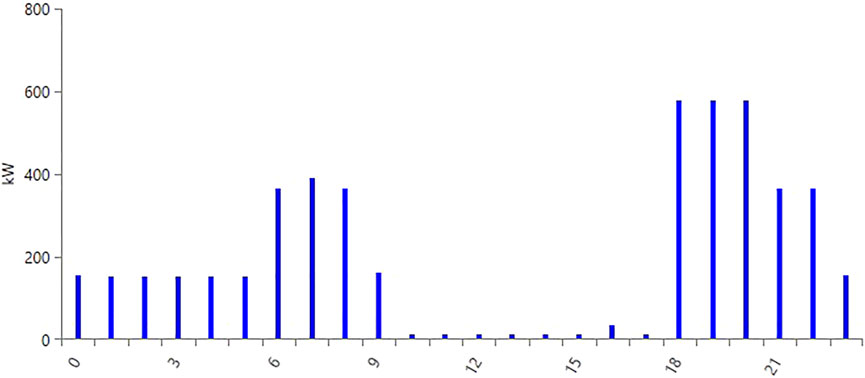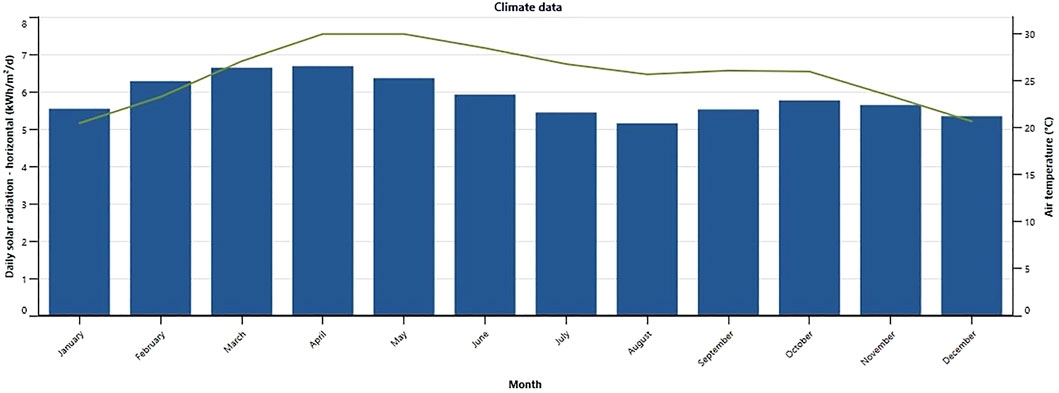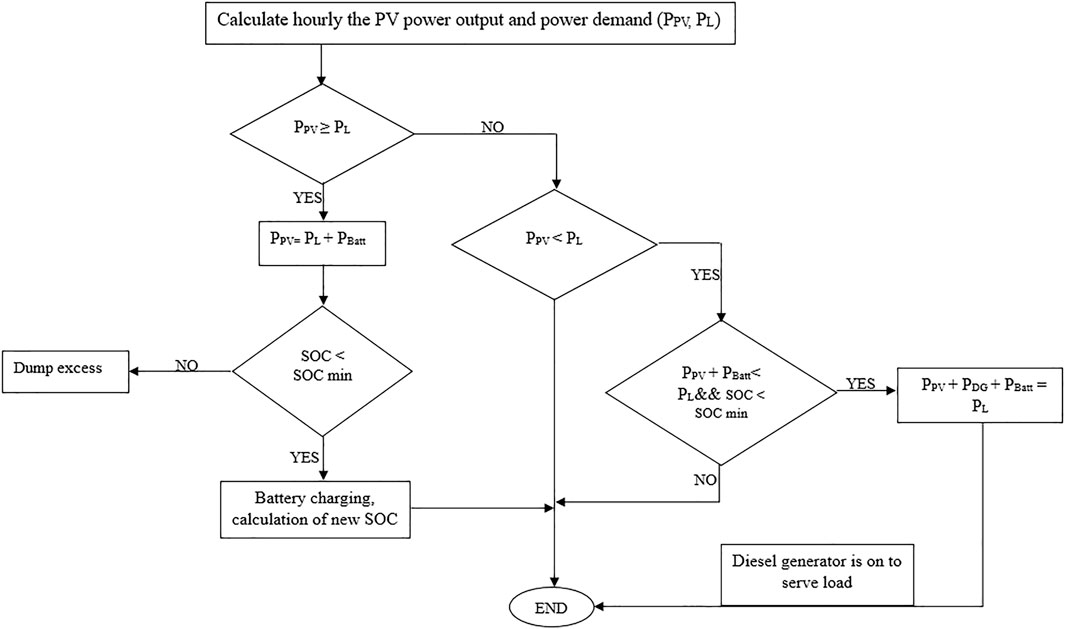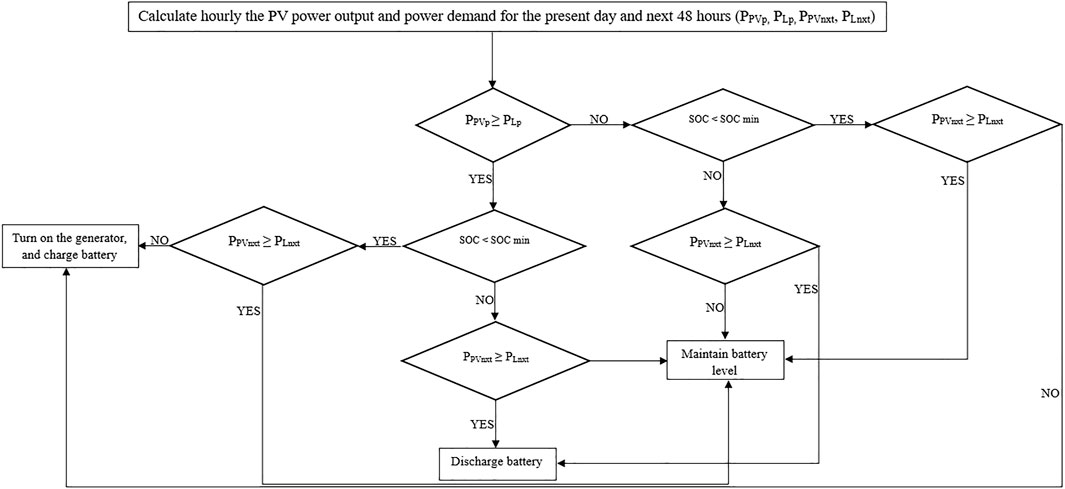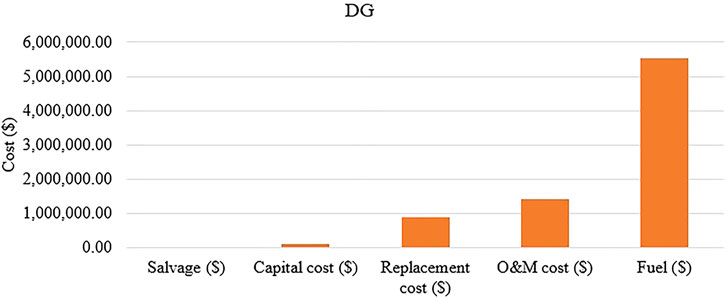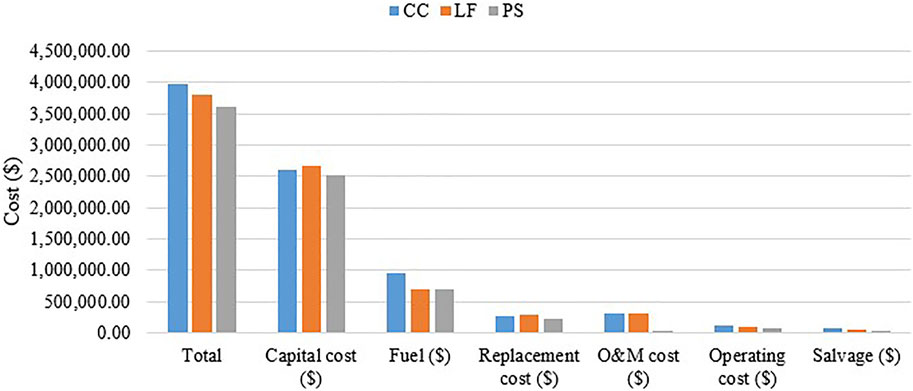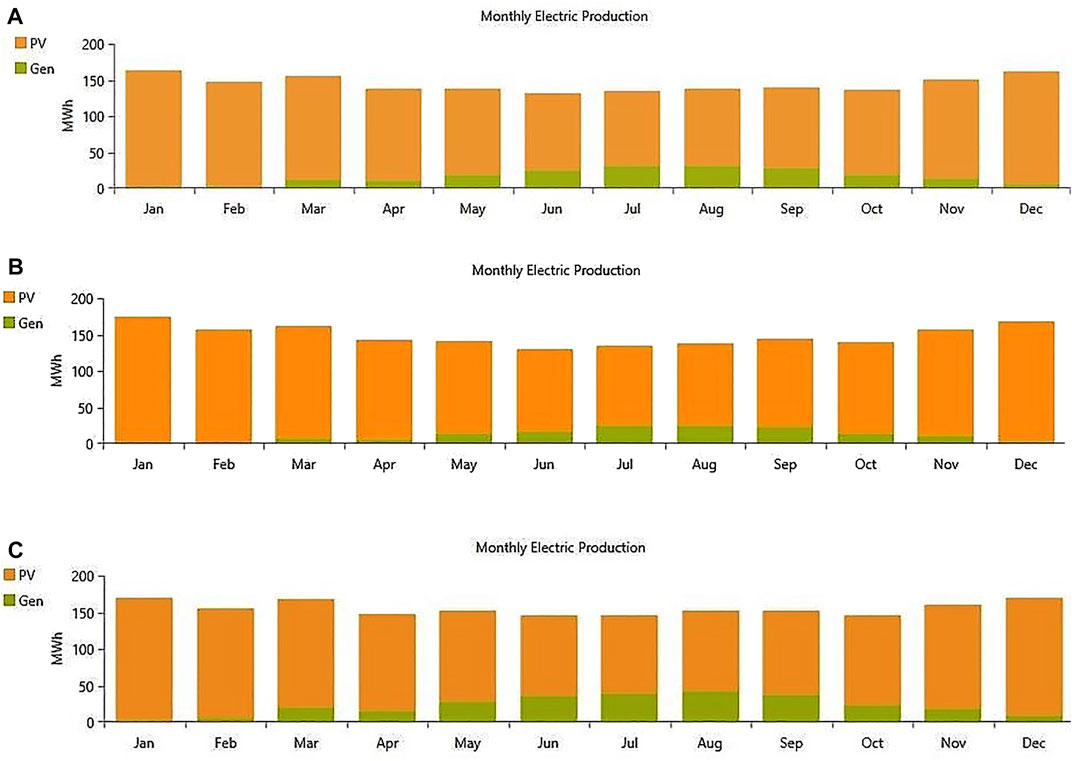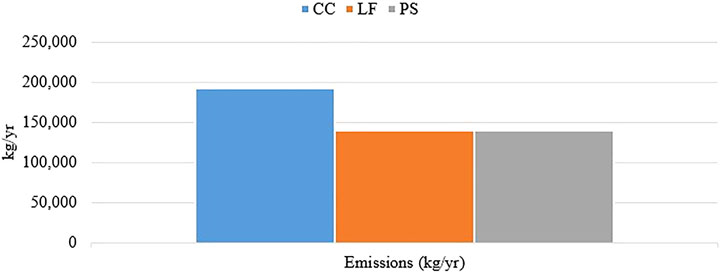- 1Department of Energy Convergence and Climate Change, Department of Convergence and Fusion System Engineering, Institute for Global Climate Change and Energy, Kyungpook National University, Daegu, South Korea
- 2Department of Computer Engineering, College of Technology, University of Buea, Buea, Cameroon
The recent use of hybrid renewable energy systems (HRESs) is considered one of the most reliable ways to improve energy access to decentralized communities because of their techno-economic and environmental benefits. Many distant locales, such as camps in war-torn nations, lack basic necessities like power. This study proposes a remedy for power outages in these areas; by designing an HRES and a control system for monitoring, distributing, and managing the electrical power from sustainable energy sources to supply the load. Hence, providing affordable, reliable, and clean energy for all (Sustainable Development Goal 7). In this study, the feasibility and techno-economic performance of an HRES for a refugee camp was evaluated under load following (LF), cycle charging (CC), and predictive control strategy (PS). The optimization results revealed that the PS was the most suitable, as it had the lowest cost and was more eco-friendly and energy-efficient. The predictive control strategy had a 48-h foresight of the load demand and resource potential and hence could effectively manage the HRES. The total net present cost (NPC) for the electrification of this refugee camp was $3,809,822.54, and the cost of electricity generated for every kWh is $0.2018. Additionally, 991,240.32 kg of emissions can be avoided annually through the hybridization of the diesel generator under the PS.
1 Introduction
Energy is one of the main elements required for the development and growth of a country. The global population and the emergence of new technologies are on an ever-increasing trend, creating a vast gap in energy demand and supply. Due to this gap and the overexploitation of currently available resources, primary energy resources, such as fossil fuels, are reaching a state of depletion. It is worth noting that the primary source of energy in the world is fossil fuels, which constitute approximately 84% of the total global energy system (Mubaarak et al., 2021). Power generation is unsustainable because of the overexploitation of fossil fuels and their adverse effects on the environment. With this in mind, the development and deployment of sustainable energy technologies are on the rise (Chowdhury et al., 2020). In this context, renewable energy is considered an effective means of providing sustainable energy generation that is affordable, accessible, and reliable (Mubaarak et al., 2021) and supported by the United Nations (UN) Sustainable Development Goals (SDGs) (Manoj Kumar et al., 2020). The IEA forecasts that Africa’s total energy consumption and power demand will increase at average annual rates of 1.4% and 2.6%, respectively. Unfortunately, as of 2019, approximately 770 million people still do not have access to electricity, with 75% of this population in the sub-Saharan region of Africa, the majority of which live in rural areas (Jahangiri et al., 2019; IEA, 2020).
Furthermore, according to the United Nations High Commissioner for Refugees (UNHCR), 9.2% of the 770 million people are displaced individuals and refugees who have been forced away from their homes by natural disasters or wars (I. Renewable Energy Agency, 2019). These individuals rely solely on unsustainable polluting energy, which sometimes poses a significant risk to their security, health, and well-being (Aste et al., 2017). Usually, on the scale of preference of humanitarian organization actions in response to refugee needs, access to clean and reliable energy is considered a low priority (van Hove and Johnson, 2021). This is a result of inadequate funding and limited policies and practices within the humanitarian organization concerning the provision of reliable and sustainable clean energy (van Hove and Johnson, 2021). In contrast, access to reliable and sustainable energy in a refugee camp can quickly boost the social, economic, productivity, safety, and health aspects of refugees and displaced persons, the host country, and humanitarian organizations (I. Renewable Energy Agency, 2019). According to the UNHCR, Cameroon has 1.9 million persons of concern (PoC) and 460,317 refugees and asylum seekers (spread across eight camps). A total of 1,052,591 internally displaced persons (IDPs) and 466,578 returned IDPs (Septembre, 2014; UNHCR, 2021). The provision of necessities for sustenance and productivity for these PoCs is mainly by the local government, with support from the humanitarian organization, and other benevolent individuals (van Hove and Johnson, 2021).
In addition, studies have shown that most refugee camps rely on diesel generators and other conventional sources, such as fuelwood, kerosene lamps, and candles, for their daily needs and other settlement services. Aside from the environmental and health detriments, fuel prices usually fluctuate, making them unreliable (Grafham and Lahn, 2018; Solar Energy, 2022). The transition from these conventional sources to renewable energy is required to bridge the gap in energy access to these camps. Thus, this study aimed to design an optimal hybrid renewable energy system (HRES) for the Gado Badzarre refugee camp in the eastern region of Cameroon using the hybrid optimization of multiple energy resources (HOMER). This HRES will go a long way to improve the livelihood of PoCs within the camp, contribute to the reduction of greenhouse gas (GHG) emissions and also act as a means of ensuring reliable, affordable, sustainable and clean energy for all.
Many researchers have worked on HRESs using HOMER for off-grid and grid electrification. Table 1 summarizes some recent studies. While the technologies used in each study differ, most of the HRESs in Table 1 are clean energy-based. The optimal component sizing of an HRES was investigated in (Chand et al., 2019; Kumar et al., 2020; Abada et al., 2021; Aditya et al., 2021). Their research concluded that to size the components of HRESs properly, effective control management strategies need to be implemented because of dispatchable components, such as batteries and diesel generators. Various studies have proposed dispatch strategies (such as load following and cycle charging) to control the operation of generators and batteries in HRESs. (Ansong et al., 2017; Halabi et al., 2017) used the load following strategy (LF) to analyze the performance of their proposed HRES to obtain the optimal size of the components. The size of each component differed across both studies. Similarly, Rajbongshi et al. (2017) and Murugaperumal and Ajay D Vimal Raj (2019) investigated the optimum HRES design with variation in the state of charge under the cycle charging (CC) strategy. Other studies employed both strategies to determine the best strategy for the proposed HRES. Singh et al. (2017) designed a standalone wind/diesel/battery HRES under LF and CC dispatch strategies. Their results indicate that LF produced the best performance based on the renewable fraction. Nsafon et al. (2020) carried out an optimization and sustainability analysis of a PV-wind-diesel hybrid energy system for decentralized energy generation using HOMER. They varied the PV slope and wind turbine hub height under the LF and CC dispatch strategies to supply the load. The results showed that for this residential estate, the best option was PV-wind-diesel with a PV slope and hub height of 3° and 75 m, respectively, under the LF strategy. A comparative study was conducted by Shoeb and Shafiullah (2018) for the PV/diesel HRES under the FL and CC strategies. They concluded that CC was the most suitable based on net present cost (NPC), cost of electricity (COE), and GHG emissions. Aziz et al. (2019) proposed a combined dispatch strategy (CD) for the energy management and optimization of PV/diesel/battery HRES. In their study, they evaluated the performance of the HRES under LF, CC, and CD. They concluded that the CD showed the best economic and environmental results. Das and Zaman (2019) carried out performance analysis of dispatch strategies, batteries, and generator selection on a PV/diesel HRES. The results showed that CD outperformed LF and CC.
Based on the above literature, HOMER has been used to design various HRESs for refugee camps and other settlements using different control strategies. Still, none has employed a predictive control strategy. Furthermore, no study has adopted a predictive control strategy as an energy management technique for modeling an HRES. In this context, we propose the design of an optimal HRES with HOMER, primarily focusing on refugee camps in Cameroon, with the principal aim of modeling and designing an affordable, reliable and sustainable HRES that combines alternative sources using a predictive control strategy. To achieve the stated objective, the scope of this study is as follows:
• Perform a techno-economic and environmental design and modeling of an HRES.
• Carry out a comprehensive performance analysis of the different control strategies employed in hybrid PV/diesel/battery systems.
• Evaluate the predictive control strategy as an energy management technique.
• Finally, perform a sensitivity analysis of the HRES under the predictive control strategy.
2 Materials and methods
The proposed schematic diagram of the hybrid system, comprising a solar PV, diesel generator, Li-ion battery, bidirectional converter, and the load as its components, is shown in Figure 1. The DC bus had a solar PV and battery system, whereas the AC bus had a diesel generator. The battery and generator acted as backups for the proposed micro-grid system.
The system algorithm for the optimization process of the refugee camp by HOMER is shown in Figure 2. This section details the study area, load profile, resource data, component specifications, mathematical modelling, and control strategies.
2.1 Study area
The Gado refugee camp (Table 2) is located in eastern Cameroon. It is the largest of the four camps in this region and the second-largest in Cameroon (Kehdinga and Zacharie, 2020). The camp covers approximately 55 ha and is located in Lom–et–Djerem, approximately 78 km2 from the border between Cameroon and the Central African Republic (CAR). The total camp population is 28,181 inhabitants, most of whom are refugees from the CAR (SEPTEMBRE, 2021).
Two seasons exist in this region: the wet and dry seasons, with an annual average temperature of 23°C. In the evenings, the primary light sources used in the camp households include oil and solar lamps, candles, and fuelwood. The location of the refugee camp is shown in Figure 3.
2.2 Load profile and resource data
Electricity is a crucial factor in improving the living standards and well-being of citizens, as it is used for lighting, communication, and motor applications. The potential needs of the location were assessed, and different loads were identified, such as the domestic load, which mainly comprised compact fluorescent lamps (CFLs) for lighting; commercial loads, which include refrigerators, computers, and CFLs; and community loads arising from the healthcare centre, kindergarten, and primary school located in the area (SEPTEMBRE, 2021). The ratings of all electrical appliances, their time of use, and the corresponding number of appliances are listed in Table 3. From the information gathered in this study, the total daily load demand (kWh) of the camp was calculated using Eq. 1 (Ramesh and Prasad Saini, 2020):
From the calculations, the daily average load was estimated to be 3,830.805 kWh, with a peak load of 365.645 kW between 6 p.m. and 8 p.m. HOMER software generated the load profile for the refugee camp, as shown in Figure 4. The renewable resource potential for this region is solar, wind, and river-run type hydropower (on the river Lom). The renewable power source considered in this study is solar, with an estimated average annual solar radiance of 5.3 kWh m−2/day in this region (Figure 5). This selection was made due to a lack of accurate information on the other sources, such as a river or headstream velocity. Furthermore, the average wind speed in this area is 2.23 m s−1, which is too low to harness the power.
2.3 Component specification and economic modelling
2.3.1 Component modelling
The solar PV performance is affected by various operating and environmental conditions. The power output of the module varies according to solar irradiation, ambient temperature, and wind velocity (Mandal et al., 2018). Eq. 2 was used to calculate the hourly power output of the PV module (Mandal et al., 2018), where PPV (kW) is the power output, YPV (kW) is the rated capacity of the PV array, FPV (%) is the derating factor, GT (kW·m−2) is the solar radiation incident on the PV array, GT, STC (1 kW/m2) is the incident radiation under standard test conditions (STC), αp (%/oC) is the temperature coefficient of power, and Tc (°C) is the PV cell temperature at the current time step. Table 4 presents the technical and economic data for the components (Ramesh and Prasad Saini, 2020), (Owolabi et al., 2019; Diesel Generators, 2021; Richardvigilantebooks, 2021). A mono–Si–CSUN200–72M solar PV system was used in this study with an efficiency of 15.67%, a temperature coefficient of 0.4%, and a nominal operating temperature of 45°C. This PV module was chosen because it is relatively cheap and available in the African market (Owolabi et al., 2019).
Owing to the intermittent nature of solar resources, an energy storage system (ESS) was required to increase the reliability and resilience of the designed microgrid. In this case, a 100 kW Lithium-ion battery was used as the energy storage system. When excess electricity was produced, the battery stored this excess electricity and discharged it when the demand was more significant than the supply. The state of charge (SOC) of the battery was calculated by HOMER using Eq. 3 (Toopshekan et al., 2020):
where
In addition, a diesel generator was included in the system design because renewable sources and the ESS are sometimes unable to meet the demand. Eq. 4 determined the quantity of fuel required by the diesel generator (Mandal et al., 2018):
where
Since we have both AC and DC bus bars, power conversion is needed. In this study, a power converter acted as an inverter (DC-AC) and a rectifier (AC-DC). It maintains the electrical connection between the AC bus and DC bus components. Table 4 provides the converter’s cost factors. The inverter input had lifetime and efficiency specifications of 15 years and 95%, but the rectifier input has a relative capacity of 100% and an efficiency of 85% (Owolabi et al., 2019). Eq. 5 calculates the converter power capacity levels where Li and Lr stand for inductive and resistive loads, respectively.
2.3.2 Optimization modelling
HOMER presents its results according to the lowest net present cost (NPC), which indicates the total life cycle cost of the system. The NPC comprises the initial, replacement, O&M, and fuel costs (Olatomiwa et al., 2018). Eq. 6 provided the formula for calculating the NPC:
Where CRF is the capital recovery factor and is determined as (Olatomiwa et al., 2018):
Where
Moreover, the total annual cost of the proposed hybrid system is expressed as (Toopshekan et al., 2020):
Where
In addition, the cost of electricity (COE), which is the average cost of power (kWh) delivered by the system, is considered an essential factor in this study. The COE was calculated as follows (Olatomiwa et al., 2018; Toopshekan et al., 2020):
2.4 Constraints
This study set some constraints to obtain an optimal, resilient, and reliable micro-grid design. The total capacity shortage was set to 0%, indicating that all feasible solutions provided by HOMER should be able to meet the demand at all times. Furthermore, the maximum renewable penetration (RP) ranged from 0 to 100%. The day-to-day (5%) and timestep (10%) were considered to compensate for the panel’s output due to unpredicted weather changes. The capacity shortage of the system was set to 0. Only systems that can satisfy the load are included in the optimized results. Also, the overall lifetime of the design was set to 25 years.
2.5 Control strategy/energy management
In a hybrid system, a dispatch strategy is employed when renewable resources cannot satisfy the load demand. A dispatch strategy is simply a control algorithm used to switch between the generator and battery bank when the available renewable energy sources cannot satisfy the load demand (Nsafon et al., 2020). By default, HOMER has two control strategies: load following (LF) and cycle charging (CC) (HOMER, 2021). Load following is a strategy in which the generator meets the immediate load demand when other generating sources are insufficient to satisfy the required demand. In this case, charging the battery is the sole responsibility of other generating sources (Nsafon et al., 2020). Renewable energy sources are reserved for lower priority tasks like recharging the storage bank or supplying the deferrable load. The load following strategy uses HOMER to dispatch the system’s controllable power sources (generators, grid, and storage bank) to satisfy the operating reserve requirement while providing the primary load and the thermal load at the lowest total cost possible for each time step (HOMER, 2021). Under CC, the generator operates at full power output, providing power to charge the battery and deliver power to the load. With this strategy, a set point of the state of charge can be set for the battery so that the generator continues to charge the battery unless the setpoint is attained before it can be discharged. Excess electricity generation is directed toward lower-priority goals such as, in declining order of priority: feeding the deferred load, charging the storage bank, and serving the electrolyzer. When adopting the cycle charging method, HOMER dispatches the controllable power sources (generators, storage bank, and grid) in a two-step procedure at each simulation time step. HOMER first chooses the best mix of power sources to supply the primary load at the lowest total cost while still meeting the need for operating reserves. Next, the output of each generator in that ideal combination is gradually increased by HOMER until it reaches its rated capacity, or as close to it as feasible without generating too much electricity. The flowchart for FL and CC are presented in Figures 6, 7, respectively.
In this study, a predictive control strategy (PS) was proposed. The upcoming load and availability of resources were predicted from NASA’s available solar radiation data for that particular time. In HOMER, this strategy gives a 48 h foresight of the load and available solar resources to harness the excess energy rather than curtail the produced energy (HOMER, 2021). The control algorithm prioritizes discharging the battery rather than turning on the generator in anticipation of harnessing the excess produced by the solar PV. The algorithm for this strategy is illustrated in Figure 8. This strategy calculates the current load demand and PV power output for the 2 days ahead. Suppose that the resource potential of the next day is greater than the demand of the present day. In this case, the battery is discharged, anticipating the ability to use the excess electricity generated the next day to recharge. However, if the reverse is true, the battery is charged in anticipation of supplying the required load for the following day. This is a control strategy and an energy management strategy, as the excess energy produced by the system is negligible.
3 Results and discussion
In this study, the proposed case under the three strategies was compared to the base case, which comprised only a diesel generator. First, the results of the various systems are presented.
3.1 Base case
The system configuration comprised only a diesel generator with a capacity of 420 kW. The initial investment for the base case was $126,000 because the only component was a 420 kW generator. This system could meet the demands of the refugee camp. The cost summary of this system is presented in Figure 9.
In Cameroon, as of 2020, the price of diesel fuel was 575 FCFA/L ($1.019/L) (Global Petrol Prices, 2021), and as shown in Figure 9 above, the fuel consumption was the highest contributor to the NPC ($7,973,412.00), followed by the O&M cost. The main drawback of this system in financial terms was the cost incurred from the fuel, and the price of fuel fluctuates, implying that the NPC of such a system can increase or decrease. Additionally, because it was a diesel generator, GHG emissions were inevitable in the system. Table 5 lists the various GHGs associated with this system. The total annual GHG emissions were 1,130,832.6 kg/yr.
3.2 Economic dimension
The economic performance of the proposed solar PV/diesel generator/battery system under different control strategies is presented in Table 6, in which essential parameters such as NPC, COE, simple payback, discounted payback, and return on investment (ROI) are highlighted. The NPC of a system is the difference between the present cost incurred from the installation and operation of the various components of the system over their life cycle and the revenues generated during the total life cycle of the project (Ishraque and Ali, 2021). From the analysis, the PS had the lowest NPC and COE, followed by the LF and CC strategies. Figure 10 shows a cost summary of the different designs. Feasibility studies have proven that renewable energy requires high upfront capital. This study is not an exception as one can realise that the initial capital is very high under all the strategies as at least 80% of the total generating capacity is supplied by the solar PV. Also, apart from the initial cost, fuel was the second-highest contributor to the NPC under the CC strategy because it had the highest generator operating hours. Even though the generator’s working hours under the CC were only 1.26% higher than those under the LF strategy, their fuel consumption disparity was 24.15%. Under the CC strategy, the generator operated at rated power, whereas under LF, the generator ran to meet the unmet load. In addition, the simple payback period, which is the time for an investor or business to redeem itself on the investments made on a project (Aziz et al., 2021), was the least for the PS (4.52 years) compared to the CC strategy (4.92 4.83 years). Hence, the most viable strategy to implement from an investor’s standpoint is the PS.
3.3 Technical dimension
The technical performance was evaluated in this study based on electrical analysis (Table 7; Figure 11). The results show that the three control strategies implemented were able to meet the load demand of the refugee camp. Figures 11A–C present the monthly electric production from various components under the LF, PS, and CC control strategies, respectively. PV/battery catered for the demand from December through February, whereas diesel generators were needed to meet the demand during the other months. The total annual electricity generated by the was 1,736,948 kWh (PS) with 85.3% generated from renewable, 1,787946 kWh (LF) with 89.1% generated by PV alone and finally 1,867,946 kWh (CC) with 79.7% generated by the solar PV respectively. Furthermore, excess electricity was produced during the first 2 months (January and February) and the last month of the year (December) with LF (14.0%), CC (16.8%), and PS (5.7%). The PS had the least excess because this control strategy could predict the solar radiation and load demand; hence, the battery charges and discharges were effectively managed.
3.4 Climate dimensions
In addition, the climate impact of the proposed system under the different strategies was assessed in this study as climate-related issues are now on every development plan in the world, and most seek to take positive actions to combat these issues. Consequently, to develop a reliable and sustainable power system, both techno-economic and climate impacts must be assessed. Generally, the lowest GHG emitter is considered more climate-friendly. The proposed system configuration consists of a diesel generator that uses fuel. Emissions such as carbon dioxide (CO2), carbon monoxide (CO), nitrogen oxide (NOx), sulfur dioxide (SO2), unburned hydrocarbons, and particulate matter cannot be avoided but can be controlled (Aziz et al., 2021). The performance evaluation of the effects of the different strategies in terms of their climate impact was investigated, and the results are shown in Figure 12. The total emissions were calculated as 192, 613, 141,357, and 139,592 kg/yr for CC, LF, and PS, respectively. These results confirm that the amount of emission is directly proportional to the quantity of fuel consumed by the generator. The PS had the lowest fuel consumption compared with LF and CC, as indicated in Table 8.
3.5 Sensitivity analysis
Sensitivity performance was carried out to evaluate how the change in different independent variables will affect the proposed system’s dependent variable under the PS strategy because it was the best control strategy financially and environmentally. The independent variables considered in this study were the diesel price, load demand, and battery minimum state of charge (SOCmin). In contrast, the dependent variables were the fuel, generator operation, NPC, COE, battery size, and a renewable fraction (Figures 13–15). For the independent parameters, an increase or decrease in the amount was evaluated, except for load demand, which tended to increase due to the rise in the size of the refugee camp. The base case or actual values for diesel price, SOCmin, and load demand were $1.019/L, 20%, and 3830.81 kWh, respectively. Results from the sensitivity analysis show that a rise in diesel price (Figure 13) from $0.509/L to $2.02/L had a negligible effect on the generator operation. This strategy prioritized the battery in the configuration as the primary backup supply. At each time, the cost of battery discharge and battery operation were not compared. However, an increase in the diesel price increased the battery size and the expense incurred from fuel purchases. Hence, a 2.518% and 1.3% increase in NPC and COE, respectively, were observed. In addition, the operating cost increased as the diesel price increased and then decreased when the current diesel price was 50% higher than the base price. This is because the system attained a renewable fraction of 100%, which means that solar PV was the sole electricity supplier.
For the SOCmin parameter (Figure 14), an increase by a factor of ±5 (from 10 to 50) increased the NPC, COE, operating cost, battery size, and total fuel consumed by approximately 1.287%, 0.275%, 1.746%, 0.16%, and 1.19%, respectively. As the SOCmin parameter increased, the reliance of the system on the diesel generator increased. Hence, the renewable fraction was reduced, implying that additional emissions were observed, posing significant climate damage. Looking at the third parameter, which is load demand (Figure 15), increasing the load demand from 3,830.81 to 4,230.81 kWh had the following effects: COE was unaffected, NPC, operating cost, battery size, and total fuel consumed all experienced an increase of 1.793%, 1.483%, 0.008%, and 0.108%, respectively.
4 Conclusion
HRESs have proven to be the most viable and promising solution for meeting the energy demand of the Gado refugee camp, where grid extension is impossible. Furthermore, the hybridization of renewable energy systems promotes energy resilience and sustainability in any country. In this study, an optimal design of a solar PV/diesel generator/battery hybrid system was carried out to provide energy for the Gado refugee camp. Selecting an effective control strategy for a particular design is very important because it affects the performance of various system components. Three different control strategies, LF, CC, and PS, were presented for the solar PV/diesel generator/battery system. A performance comparison was carried out based on the technical, economic, and climate dimensions of the three different control strategies.
The simulation results obtained from the HOMER software indicated that the PS control strategy was best suited for this particular case study. Further performance analysis revealed that the PS strategy was the preferable choice from an investor’s point of view because it had the least NPC ($3,606,886) as compared to the LF control strategy ($3,809,822.54), CC controlled strategy ($3,981,010), and the base case (diesel only; $7,973,412.00). From a technical perspective, all the strategies under study met the demand, with the PS control strategy generating only 5.7% excess electricity compared to the LF (14.0%) and CC (16.8%) control strategies. The stand-alone base case of the diesel generator could meet the demand with no excess generation. From an environmental point of view, the PS strategy was the most climatically friendly as its total emission generation was 139,592.28 kg/yr relative to the 141,357, 192,613 and 1,130,832.6 kg/yr generated by LF, CC, and the base case, respectively. Based on these results, the PS control strategy had the lowest emissions, even though it had a similar climatic impact compared to the LF. It produces less excess energy and has the lowest cost. The optimal design of a hybrid renewable system should be eco-friendly, cost-effective and energy-efficient. With this compromise, the most suitable choice of control strategy for the solar PV/diesel generator/battery hybrid system in this case study is the PS strategy. The proposed approach can considerably increase the energy access and livelihood of similar camps and is an effective energy management technique employed in HRESs.
According to the results of this study, it is vital to develop control strategies that can be applied to the implementation of HRES. Future studies recommend a comparative analysis of the command dispatch and predictive control strategies in combination with other ESS and grid extensions.
Data availability statement
The original contributions presented in the study are included in the article/Supplementary Material, further inquiries can be directed to the corresponding author.
Author contributions
NS: conceptualization, methodology, software, formal analysis, writing–original draft. AY: investigation and data curation. BK: conceptualization, writing—review and editing. AO: writing—review and editing. TM: visualization and revision. DS: software, validation. J-SH: supervision.
Funding
This work was supported by the National Research Foundation of Korea (NRF), a grant funded by the Korean government Ministry of Science and ICT (MSIT) (No. NRF-2021R1A5A8033165); the Korea Institute of Energy Technology Evaluation and Planning (KETEP) and the Ministry of Trade, Industry & Energy (MOTIE) of the Republic of Korea (No. 20224000000150).
Conflict of interest
The authors declare that the research was conducted in the absence of any commercial or financial relationships that could be construed as a potential conflict of interest.
Publisher’s note
All claims expressed in this article are solely those of the authors and do not necessarily represent those of their affiliated organizations, or those of the publisher, the editors and the reviewers. Any product that may be evaluated in this article, or claim that may be made by its manufacturer, is not guaranteed or endorsed by the publisher.
References
Abada, I., Othmani, M., and Tatry, L. (2021). An innovative approach for the optimal sizing of mini-grids in rural areas integrating the demand, the supply, and the grid. Renew. Sustain. Energy Rev. 146, 111117. doi:10.1016/j.rser.2021.111117
Aditya, I. A., Aisyah, S., and Simaremare, A. A. (2021). Optimal sizing and sensitivity analysis of hybrid renewable energy systems: A case of ur island in Indonesia. IOP Conf. Ser. Mat. Sci. Eng. 1098 (4), 042049. doi:10.1088/1757-899x/1098/4/042049
Ansong, M., Mensah, L. D., and Adaramola, M. S. (2017). Techno-economic analysis of a hybrid system to power a mine in an off-grid area in Ghana. Sustain. Energy Technol. Assessments 23, 48–56. doi:10.1016/J.SETA.2017.09.001
Aste, N., Barbieri, J., Berizzi, A., Colombo, E., del Pero, C., Leonforte, F., et al. (2017). Innovative energy solutions for improving food preservation in humanitarian contexts: A case study from informal refugees settlements in Lebanon. Sustain. Energy Technol. Assessments 22, 177–187. doi:10.1016/j.seta.2017.02.009
Aziz, A. S., Tajuddin, M. F. N., Adzman, M. R., Ramli, M. A. M., and Mekhilef, S. (2019). Energy management and optimization of a PV/diesel/battery hybrid energy system using a combined dispatch strategy. Sustain. Switz. 11, 683–3. doi:10.3390/su11030683
Aziz, A. S., Tajuddin, M. F. N., Hussain, M. K., Adzman, M. R., Ghazali, N. H., Ramli, M. A., et al. (2021). A new optimization strategy for wind/diesel/battery hybrid energy system. Energy 239, 122458. doi:10.1016/j.energy.2021.122458
Babaei, R., Ting, D. S.-K., and Carriveau, R. (2022). Feasibility and optimal sizing analysis of stand-alone hybrid energy systems coupled with various battery technologies: A case study of pelee island. Energy Rep. 8, 4747–4762. doi:10.1016/j.egyr.2022.03.133
Baranda Alonso, J., Sandwell, P., and Nelson, J. (2021). The potential for solar-diesel hybrid mini-grids in refugee camps: A case study of nyabiheke camp, Rwanda. Sustain. Energy Technol. Assessments 44, 101095. doi:10.1016/j.seta.2021.101095
Chand, A. A., Prasad, K. A., Mamun, K. A., Sharma, K. R., and Chand, K. K. (2019). Adoption of grid-tie solar system at residential scale. Clean. Technol. 1 (1), 224–231. doi:10.3390/CLEANTECHNOL1010015
Chowdhury, T., Chowdhury, H., Miskat, M. I., Chowdhury, P., Sait, S. M., Thirugnanasambandam, M., et al. (2020). Developing and evaluating a stand-alone hybrid energy system for Rohingya refugee community in Bangladesh. Energy 191, 116568. doi:10.1016/j.energy.2019.116568
Das, B. K., and Zaman, F. (2019). Performance analysis of a PV/Diesel hybrid system for a remote area in Bangladesh: Effects of dispatch strategies, batteries, and generator selection. Energy 169, 263–276. doi:10.1016/j.energy.2018.12.014
Diesel Generators (2021). Diesel generators | large generators | cat | caterpillar. Available at: https://www.cat.com/en_US/products/new/power-systems/electric-power/diesel-generator-sets.html (Accessed Dec. 23, 2021.
Global Petrol Prices (2021). Cameroon diesel prices, 20-Dec-2021 | GlobalPetrolPrices.com. Available at: https://www.globalpetrolprices.com/Cameroon/diesel_prices/ (Accessed Dec. 24, 2021.
Grafham, O., and Lahn, G. (2018). The costs of fuelling humanitarian aid. London: The Royal Institute of International Affairs.
Halabi, L. M., Mekhilef, S., Olatomiwa, L., and Hazelton, J. (2017). Performance analysis of hybrid PV/diesel/battery system using HOMER: A case study sabah, Malaysia. Energy Convers. Manag. 144, 322–339. doi:10.1016/J.ENCONMAN.2017.04.070
HOMER (2021). HOMER_Pro_Version_3_7_User_Manual. Available at: www.homerenergy.com (Accessed: Oct. 11, 2021.
IEA (2020). SDG7: Data and projections. Paris: IEA. Available at: https://www.iea.org/reports/sdg7-data-and-projections.
I. Renewable Energy Agency (2019). Renewables for refugee settlements: Sustainable energy access in humanitarian situations. Available at: www.irena.org.
Ishraque, M. F., and Ali, M. M. (2021). “Optimized design of a hybrid microgrid using renewable resources considering different dispatch strategies,” in 2021 International Conference on Automation, Control and Mechatronics for Industry 4.0 (ACMI), Rajshahi, Bangladesh, 08-09 July 2021. doi:10.1109/ACMI53878.2021.9528096
Jahangiri, M., Soulouknga, M. H., Bardei, F. K., Shamsabadi, A. A., Akinlabi, E. T., Sichilalu, S. M., et al. (2019). Techno-econo-environmental optimal operation of grid-wind-solar electricity generation with hydrogen storage system for domestic scale, case study in Chad. Int. J. Hydrogen Energy 44 (54), 28613–28628. doi:10.1016/j.ijhydene.2019.09.130
Jegadeesan, V., Vishnupriyan, J., Raghuraman, R., and Keerthi Vijayadhasan, G. (2020). Techno-economic feasibility investigation on hybrid system using HOMER. Int. J. Future Generation Commun. Netw. 13 (1), 1276–1288. Available at: https://www.researchgate.net/publication/346935544.
Karmaker, A. K., Hossain, M. A., Kumar, N. M., Jagadeesan, V., Jayakumar, A., and Ray, B. (2020). Analysis of using biogas resources for electric vehicle charging in Bangladesh: A techno-economic-environmental perspective. Sustainability 12 (7), 2579. doi:10.3390/SU12072579
Kehdinga, V. M., and Zacharie, S. (2020). The challenges and measures put in place by some international organizations in charge of the management of refugees in the Eastern Region of Cameroon: Case of Gado Badzere refugee camp in Garoua Boulai. Available at: http://www.ijias.issr-journals.org/.
Kumar, N. M., Ghosh, A., and Chopra, S. S. (2020). Power resilience enhancement of a residential electricity user using photovoltaics and a battery energy storage system under uncertainty conditions. Energies 13 (16), 4193. doi:10.3390/EN13164193
Ma, Q., Huang, X., Wang, F., Xu, C., Babaei, R., and Ahmadian, H. (2022). Optimal sizing and feasibility analysis of grid-isolated renewable hybrid microgrids: Effects of energy management controllers. Energy 240, 122503. doi:10.1016/j.energy.2021.122503
Mandal, S., Das, B. K., and Hoque, N. (2018). Optimum sizing of a stand-alone hybrid energy system for rural electrification in Bangladesh. J. Clean. Prod. 200, 12–27. doi:10.1016/j.jclepro.2018.07.257
Manoj Kumar, N., Chopra, S. S., Chand, A. A., Elavarasan, R. M., and Shafiullah, G. M. (2020). Hybrid renewable energy microgrid for a residential community: A techno-economic and environmental perspective in the context of the SDG7. Sustainability 1212 (10), 3944. doi:10.3390/SU12103944
Mubaarak, S., Zhang, D., Liu, J., Chen, Y., Wang, L., Zaki, S. A., et al. (2021). Potential techno-economic feasibility of hybrid energy systems for electrifying various consumers in Yemen. Sustain. Switz. 13 (1), 228–324. doi:10.3390/su13010228
Murugaperumal, K., and Ajay D Vimal Raj, P. (2019). Feasibility design and techno-economic analysis of hybrid renewable energy system for rural electrification. Sol. Energy 188, 1068–1083. doi:10.1016/J.SOLENER.2019.07.008
Neves, D., Baptista, P., and Pires, J. M. (2021). Sustainable and inclusive energy solutions in refugee camps: Developing a modelling approach for energy demand and alternative renewable power supply. J. Clean. Prod. 298, 126745. doi:10.1016/j.jclepro.2021.126745
Nsafon, B. E. K., Owolabi, A. B., Butu, H. M., Roh, J. W., Suh, D., and Huh, J. S. (2020). Optimization and sustainability analysis of PV/wind/diesel hybrid energy system for decentralized energy generation. Energy Strategy Rev. 32, 100570. doi:10.1016/j.esr.2020.100570
Olatomiwa, L., Blanchard, R., Mekhilef, S., and Akinyele, D. (2018). Hybrid renewable energy supply for rural healthcare facilities: An approach to quality healthcare delivery. Sustain. Energy Technol. Assessments 30, 121–138. doi:10.1016/J.SETA.2018.09.007
Owolabi, A. B., Nsafon, B. E. K., Huh, J. S., and Suh, D. (2019). Validating the techno-economic and environmental sustainability of solar PV technology in Nigeria using RETScreen Experts to assess its viability. Sustain. Energy Technol. Assessments 36, 100542. doi:10.1016/j.seta.2019.100542
Pal, P., and Mukherjee, V. (2021). Off-grid solar photovoltaic/hydrogen fuel cell system for renewable energy generation: An investigation based on techno-economic feasibility assessment for the application of end-user load demand in North-East India. Renew. Sustain. Energy Rev. 149, 111421. doi:10.1016/j.rser.2021.111421
Rajbongshi, R., Borgohain, D., and Mahapatra, S. (2017). Optimization of PV-biomass-diesel and grid base hybrid energy systems for rural electrification by using HOMER. Energy 126, 461–474. doi:10.1016/J.ENERGY.2017.03.056
Ramesh, M., and Prasad Saini, R. (2020). Effect of different batteries and diesel generator on the performance of a stand-alone hybrid renewable energy system. Energy Sources, Part A Recovery, Util. Environ. Eff. Available at: https://www.tandfonline.com/loi/ueso20. doi:10.1080/15567036.2020.1763520
Rezaei, M., Dampage, U., Das, B. K., Nasif, O., Borowski, P. F., and Mohamed, M. A. (2021). Investigating the impact of economic uncertainty on optimal sizing of grid-independent hybrid renewable energy systems. Processes 9 (8), 1468. doi:10.3390/pr9081468
Richardvigilantebooks (2021). What is the cost of battery storage per kWh? – Richardvigilantebooks.com. Available at: https://richardvigilantebooks.com/what-is-the-cost-of-battery-storage-per-kwh/ (Accessed Dec. 23, 2021.
Seedahmed, M. M. A., Ramli, M. A. M., Bouchekara, H. R. E. H., Shahriar, M. S., Milyani, A. H., and Rawa, M. (2022). A techno-economic analysis of a hybrid energy system for the electrification of a remote cluster in western Saudi Arabia. Alexandria Eng. J. 61 (7), 5183–5202. doi:10.1016/j.aej.2021.10.041
Septembre (2014). CAMEROUN: STATISTIQUES DES PERSONNES RELEVANT DE LA COMPETENCE DU HCR evolution de la population déplacée interne et retournée EVOLUTION DE LA POPULATION (12 DERNIERS MOIS) XXX PDIs XXX Retournes. UN Refugee Agency (UNHCR). Available at: https://data.unhcr.org/en/country/cmr.
SEPTEMBRE (2021). INFORMATIONS GENERALES Population totale 28 181 Nombre de secteurs Distance avec la frontière Nombre total d’acteurs Poste de Gendarmerie Coordonnes GPS PERSONNES A BESOINS SPECIFIQUES Hommes Femmes PRINCIPAUX DEFIS 4 102 PBS PROFIL DU SITE DE GADO. UN Refugee Agency (UNHCR). Available at: https://data.unhcr.org/en/country/cmr.
Sharma, S., Sood, Y. R., Sharma, N. K., Bajaj, M., Zawbaa, H. M., Turky, R. A., et al. (2022). Modeling and sensitivity analysis of grid-connected hybrid green microgrid system. Ain Shams Eng. J. 13 (4), 101679. doi:10.1016/j.asej.2021.101679
Shoeb, M. A., and Shafiullah, G. M. (2018). Renewable energy integrated islanded microgrid for sustainable irrigation—a Bangladesh perspective. Energies 11 (5), 1283. doi:10.3390/EN11051283
Singh, A., Baredar, P., and Gupta, B. (2017). Techno-economic feasibility analysis of hydrogen fuel cell and solar photovoltaic hybrid renewable energy system for academic research building. Energy Convers. Manag. 145, 398–414. doi:10.1016/J.ENCONMAN.2017.05.014
Solar Energy (2022). Solar energy advancements in agriculture and food production systems - google books. Available at: https://books.google.co.kr/books?id=T3dQEAAAQBAJ&pg=PA391&lpg=PA391&dq=-+10.1016/B978-0-323-89866-9.00006&source=bl&ots=UDSrJtePbm&sig=ACfU3U1_KTVmvFGBursS2yYRacP8Jf8V9A&hl=en&sa=X&ved=2ahUKEwj68br61_L4AhVCIIgKHWeEBF4Q6AF6BAgCEAM#v=onepage&q=-%20https%3A%2F%2Fdoi.org%2F10.1016%2FB978-0-323-89866-9.00006&f=false (Accessed Jul. 13, 2022.
Soudan, B., and Masoud Darya, A. (2021). “Modular hybrid energy system for refugee camps,” in 2021 6th International Conference on Renewable Energy: Generation and Applications, ICREGA, Al Ain, United Arab Emirates, 02-04 February 2021, 33–38. doi:10.1109/ICREGA50506.2021.9388289
Toopshekan, A., Yousefi, H., and Astaraei, F. R. (2020). Technical, economic, and performance analysis of a hybrid energy system using a novel dispatch strategy. Energy 213, 118850. doi:10.1016/j.energy.2020.118850
UNHCR (2021). Document - UNHCR Cameroon - locations of UNHCR persons of concern. Available at: https://data2.unhcr.org/en/documents/details/90018 (Accessed Dec. 30, 2021.
Ur Rashid, M., Ullah, I., Mehran, M., Baharom, M. N. R., and Khan, F. (2022). Techno-economic analysis of grid-connected hybrid renewable energy system for remote areas electrification using homer pro. J. Electr. Eng. Technol. 17 (2), 981–997. doi:10.1007/s42835-021-00984-2
van Hove, E., and Johnson, N. G. (2021). Refugee settlements in transition: Energy access and development challenges in Northern Uganda. Energy Res. Soc. Sci. 78, 102103. doi:10.1016/j.erss.2021.102103
Keywords: hybrid renewable energy systems, predictive control strategy, techno-economic modelling, energy management, refugee camp
Citation: Same NN, Yakub AO, Kigha Nsafon BE, Owolabi AB, Mih TA, Suh D and Huh J-S (2022) Performance evaluation of renewable-based sustainable micro-grid under predictive management control strategy: A case study of Gado refugee camp in Cameroon. Front. Energy Res. 10:987495. doi: 10.3389/fenrg.2022.987495
Received: 06 July 2022; Accepted: 25 July 2022;
Published: 05 September 2022.
Edited by:
Nallapaneni Manoj Kumar, City University of Hong Kong, Hong Kong SAR, ChinaReviewed by:
Amit Kumer Podder, Khulna University of Engineering & Technology, BangladeshAneesh A. Chand, University of the South Pacific, Fiji
Gautam Raina, Malaviya National Institute of Technology, Jaipur, India
Copyright © 2022 Same, Yakub, Kigha Nsafon, Owolabi, Mih, Suh and Huh. This is an open-access article distributed under the terms of the Creative Commons Attribution License (CC BY). The use, distribution or reproduction in other forums is permitted, provided the original author(s) and the copyright owner(s) are credited and that the original publication in this journal is cited, in accordance with accepted academic practice. No use, distribution or reproduction is permitted which does not comply with these terms.
*Correspondence: Jeung-Soo Huh, anNodWhAa251LmFjLmty
 Noel Ngando Same
Noel Ngando Same Abdulfatai Olatunji Yakub
Abdulfatai Olatunji Yakub Benyoh Emmanuel Kigha Nsafon
Benyoh Emmanuel Kigha Nsafon Abdulhameed Babatunde Owolabi
Abdulhameed Babatunde Owolabi Thomas Attia Mih
Thomas Attia Mih Dongjun Suh1
Dongjun Suh1